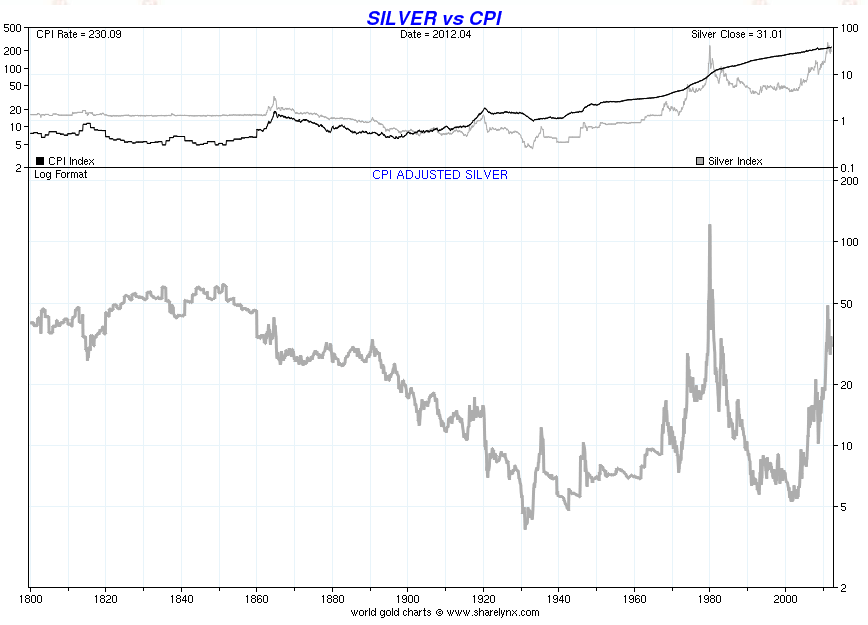5 Reasons to Buy Silver
There are a number of large factors that will affect silver over the next many years. Namely, the Quantitative Easing abuse on behalf of governments worldwide. The excessive “QE” (what we like to call “fake money implosions”) will likely result in a currency crisis in a multitude of countries. There has never, in the history of the world, been such excess in the printing of fiat currency.
1. The End of the Metals Bear Market
Even the talking heads in the mainstream media and global financial institutions are predicting an uptrend in both gold and silver prices. While gold usually takes the limelight in financial forecasting, the future is bright for silver. Look at the chart below that clearly demonstrates the silver bear market is over and we are trending in to a bull market.
2. Lowering Silver Production Costs
As the silver prices transitioned in to a downtrend in the recent metals bear market, mining companies worldwide were forced to trim infrastructure and reduce mining costs overall. Much of the cost cutting has come from mining exploration budgets, potentially limiting supply, at least in the short term.
3. The Good ‘Ol Inflation Adjusted Silver Price
There is a significant amount of upside in the silver price as demonstrated by the inflation adjusted silver price. The CPI-U used by the Bureau of Labor is a falsely modified factorization used to keep the inflation number as low as possible. If you revert back to a pure CPI-U that has not been unethically altered you can clearly see what the silver price could be:

Relative to the cost of production, the silver price is at its lowest level since 2005. Keep in mind that cash costs are only a portion of all-in expenses, and the silver price has historically traded well above this figure (all-in costs are just now being widely reported). That margins have tightened so dramatically is not sustainable on a long-term basis without affecting the industry. It also makes it likely that prices have bottomed, since producers can only cut expenses so much.
Although roughly 75% of silver is produced as a by-product, prices are determined at the margin; if a mine can’t operate profitably or a new project won’t earn a profit at low prices, the resulting drop in output would serve as a catalyst for higher prices. Further, much of the current cost-cutting has come from reduced exploration budgets, which will curtail future supply.
4. Low Inventories
Sovereign governments, including the United States Government used to hold large silver bullion in large quantities. With US coinage no longer containing any amount of silver, instead are minted from base metals, having no value other than their perceived face value. As a result, the need to hold large inventories of coinage is no longer needed.
You can see how low current inventories are on a historical basis, most of which are held in exchange-traded products. This is important because these investors have been net buyers since 2005 and thus have kept that metal off the market. The remaining amount of inventory is 241 million ounces, only 25% of one year’s supply—whereas in 1990 it represented roughly eight times supply. If demand were to suddenly surge, those needs could not be met by existing inventories. In fact, ETP investors would likely take more metal off the market. (The “implied unreported stocks” refers to private and other unreported depositories around the world, another strikingly smaller number.)
If investment demand were to repeat the surge it saw from 2005 to 2009, this would leave little room for error on the supply side.
5. Low Mainstream Participation
Another indicator of silver’s potential is how much it represents of global financial wealth, compared to its percentage when silver hit $50 in 1980.
In spite of ongoing strong demand for physical metal, silver currently represents only 0.01% of the world’s financial wealth. This is one-twenty-fifth its 1980 level. Even that big price spike we saw in 2011 pales in comparison. There’s an enormous amount of room for silver to become a greater part of mainstream investment portfolios.
Based on this review of big-picture data, what conclusion would you draw? If you’re like me, you’re forced to acknowledge that the next few years could be a very exciting time for silver investors.
Just like gold, our stash of silver will help us maintain our standard of living—but may be even more practical to use for small purchases. And in a high-inflation/decaying-dollar scenario, the silver price is likely to exceed consumer price inflation, giving us further purchasing power protection.
The bottom line is that the current silver price should be seen as a long-term buying opportunity. This may or may not be our last chance to buy at these levels for this cycle, but if you like bargains, silver’s neon “Sale!” sign is flashing like a disco ball.